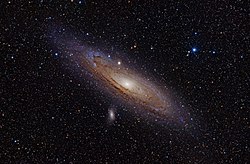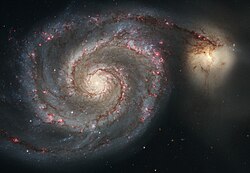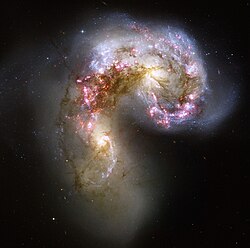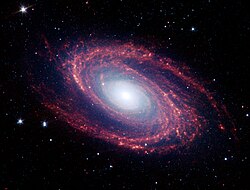Cartwheel Galaxy
Astronomer Bob Fosbury, who is stepping down as Head of the ST-ECF, was responsible for much of the early research into the Cartwheel Galaxy along with the late Tim Hawarden — including giving the object its very apposite name — and so this image was selected as a fitting tribute. The object was first spotted on wide-field images from the UK Schmidt telescope and then studied in detail using the Anglo-Australian Telescope.
Lying about 500 million light-years away in the constellation of Sculptor, the cartwheel shape of this galaxy is the result of a violent galactic collision. A smaller galaxy has passed right through a large disc galaxy and produced shock waves that swept up gas and dust — much like the ripples produced when a stone is dropped into a lake — and sparked regions of intense star formation (appearing blue). The outermost ring of the galaxy, which is 1.5 times the size of our Milky Way, marks the shock wave’s leading edge. This object is one of the most dramatic examples of the small class of ring galaxies.
This image was produced after Hubble data was reprocessed using the free open source software FITS Liberator 3, which was developed at the ST-ECF. Careful use of this widely used state-of-the-art tool on the original Hubble observations of the Cartwheel Galaxy has brought out more detail in the image than ever before.
Although the ST-ECF is closing, ESA’s mission to bring amazing Hubble discoveries to the public will be unaffected, with Hubblecasts, press and photo releases, and Hubble Pictures of the Week continuing to be regularly posted on spacetelescope.org| This file is in the public domain because it was created by NASA and ESA. NASA Hubble material (and ESA Hubble material prior to 2009) is copyright-free and may be freely used as in the public domain without fee, on the condition that only NASA, STScI, and/or ESA is credited as the source of the material. This license does not apply if ESA material created after 2008 or source material from other organizations is in use. The material was created for NASA by Space Telescope Science Institute under Contract NAS5-26555, or for ESA by the Hubble European Space Agency Information Centre. Copyright statement at hubblesite.org or 2008 copyright statement at spacetelescope.org. For material created by the European Space Agency on the spacetelescope.org site since 2009, use the {{ESA-Hubble}} tag. |
Relevante Bilder
Relevante Artikel
Wechselwirkende GalaxienWechselwirkende Galaxien sind Galaxien, die sich gegenseitig beeinflussen und damit ihre inneren Aktivitäten erhöhen. .. weiterlesen
GalaxieEine Galaxie ist eine durch Gravitation gebundene große Ansammlung von Sternen, Planetensystemen, Gasnebeln, Staubwolken, Dunkler Materie und sonstigen astronomischen Objekten mit einer Gesamtmasse von typischerweise 109 bis 1013 Sonnenmassen (M☉). Ihr Durchmesser kann mehrere hunderttausend Lichtjahre betragen. Während große Galaxien häufig die Struktur von Spiralen ausbilden, sind Zwerggalaxien zumeist irregulären Typs. Daneben existieren weitere Arten und Formen. Die Milchstraße, Heimatgalaxie unseres Sonnensystems, ist eine Balkenspirale von rund 1,5 Billionen M☉ mit etwa 250 Milliarden Sternen. Von der Erde aus lassen sich mit aktueller Technik mehr als 50 Milliarden Galaxien beobachten. Seit 2016 geht die Forschung davon aus, dass sich im beobachtbaren Universum ca. eine Billion Galaxien befinden. .. weiterlesen
RinggalaxieEine Ringgalaxie ist eine seltene, durch Wechselwirkung zweier Galaxien entstandene Galaxienform. Ringartige Strukturen treten aber auch in anderen Galaxienformen wie Polarring-Galaxien und manchen Balkenspiralgalaxien auf. .. weiterlesen


























